| Title | Elite Beat Agents |
| Released | November 8 2006 |
| Developer(s): | iNiS corporation |
| Publisher(s): | Nintendo Co., Ltd. |
| Platform(s): | |
| Genre | Music, Rhythm |
| Rating | E10+ |
Completed on Nintendo 3DS on Breezin’
HowLongToBeat Time: 4h | My Clear Time: 3hrs 35m
Background
Released on November 8, 2006, for the Nintendo DS, Elite Beat Agents is the Western adaptation of the Japan-only Osu! Tatakae! Ouendan. The game’s director, Keiichi Yano, highlighted its casual appeal, stating, “Music games lend themselves to a more casual market.” This design choice aligned with the growing popularity of accessible, touch-based games at the time.
To appeal to Western audiences, Elite Beat Agents replaced Ouendan’s Japanese pop songs and cultural humor with a new cast, Western hits, and over-the-top narratives. Despite this shift, it retained the quirky humor and emotional depth that made its predecessor beloved. Yano noted, “They’re the same game, essentially, but with very different graphics and song choices.”
While it didn’t achieve commercial success as hoped, the game gained a cult following for its innovative rhythm gameplay and infectious energy. It even saw moderate success in Japan, reflecting its universal charm and creative execution (Nutt, 2007).
The development team for Elite Beat Agents includes:
- Koji Ito, Kishiko Miyagi (Scenario)
- K?ji is known for Bounty Hunter Sara: Holy Mountain no Tei?, Mikomai: Towa no Omoi
- Kishiko is known for Dino Crisis 2, Bounty Hunter Sara: Holy Mountain no Tei?, Onimusha 2: Samurai’s Destiny
- Keiichi Yano (Director, Game Design)
- Disaster: Day of Crisis, Osu! Tatakae! Ouendan, Gitaroo Man Lives!
- Atsushi Saito (Character Designer / Artist)
- Osu! Tatakae! Ouendan, Gitaroo Man, God Eater 3
- Satoshi Tani (Sound Design)
- Elite Beat Agents, Demons’ Score, Giraffe and Annika
- Masako Harada, Shinya Saito (Producers)
- Masako is known for Osu! Tatakae! Ouendan, Elite Beat Agents
- Shinya is known for Osu! Tatakae! Ouendan, Trace Memory, Xenoblade Chronicles 3
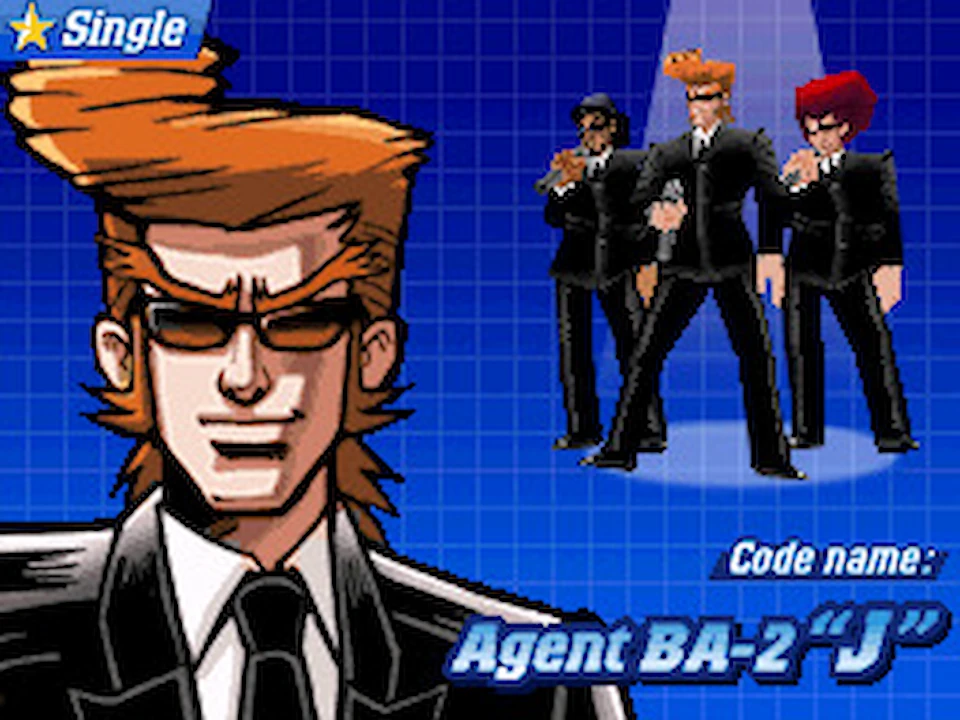
Agent BA-2 “J” strikes a pose, ready to save the day with rhythm and style.
Experience
Before playing Elite Beat Agents, I had extensive experience with rhythm-based games, including titles like Guitar Hero 1-3, Rock Band 1-3, DJ Hero 1 & 2, Frets on Fire, Persona Dancing, and more recently, Beat Saber. These games have been a big part of my gaming journey, offering a range of rhythm mechanics from guitar controllers to dance pads to VR sword slashing.
Having played Beat Saber, where the focus is on physicality and visual elements, I was curious how Elite Beat Agents would translate its rhythm gameplay to the Nintendo DS’s touchscreen, especially given its more narrative-driven approach and use of tapping and sliding to the beat. I was also interested in seeing how this handheld classic would compare to the immersive experiences I’ve had with other rhythm games.
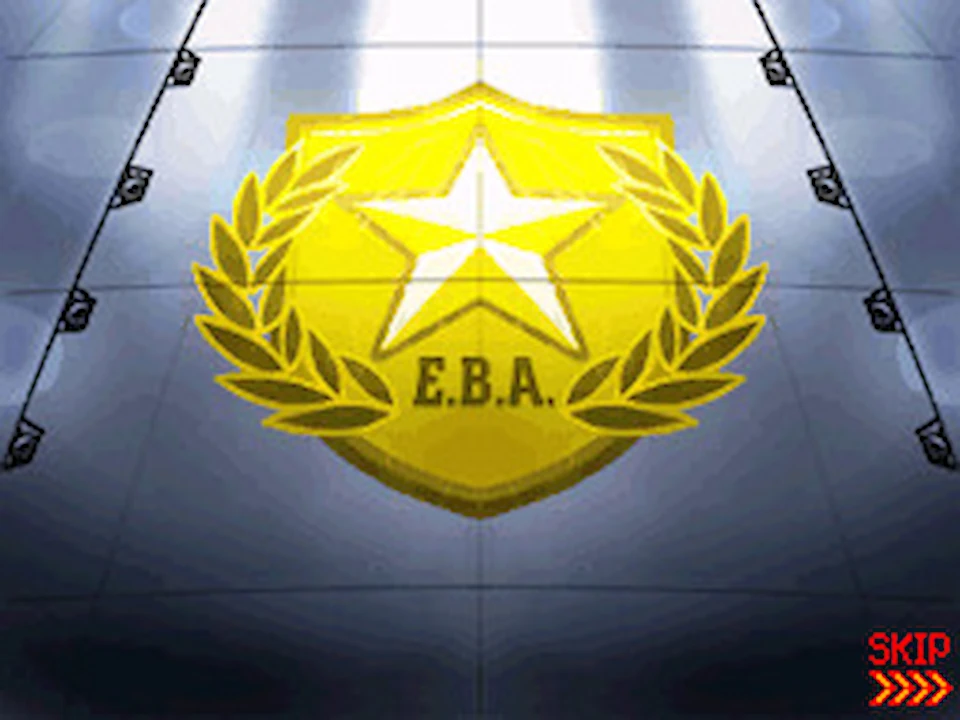
The iconic E.B.A. gold star flashes across the screen, signaling the arrival of musical justice.
Impressions
Introduction
Elite Beat Agents isn’t your typical rhythm game. Released for the Nintendo DS in 2006, it combines quirky humor, heartfelt storytelling, and an eclectic soundtrack with tap-and-swipe gameplay that takes full advantage of the touchscreen. At its core, the game is about an elite group of secret agents who solve people’s problems—not with brute force or gadgets, but by dancing.
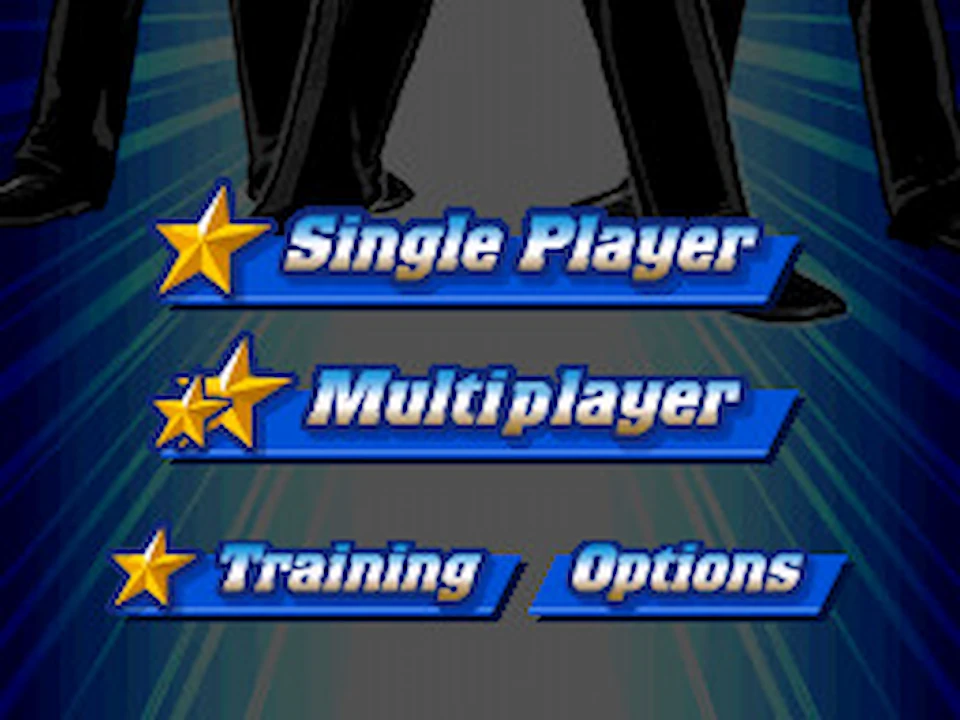
The main menu lets players jump into rhythm-saving action solo or with friends.
Whether it’s helping a babysitter calm crying children or motivating a washed-up baseball player to make a comeback, Elite Beat Agents turns every mission into an over-the-top, music-fueled adventure. For fans of rhythm games and those looking for a uniquely charming experience, this cult classic holds a special place in the genre’s history.
Gameplay and Mechanics
At its core, Elite Beat Agents shares a familiar goal with other rhythm games: syncing your timing to the beat of the music. However, it stands apart from titles like the Guitar Hero series or Persona Dancing games by using a unique gameplay style akin to Osu!—tapping and sliding on the Nintendo DS touchscreen in rhythm with numbered circles and markers. This tactile approach feels intuitive but demands precision, offering a deceptively challenging experience even on the easiest difficulty, Breezin’.
The game features four main difficulty levels: Breezin’, Cruisin’, Sweatin’, and the unlockable Hard ROCK! Each one speeds up note patterns and introduces more complex sequences, providing a progressively steeper learning curve. Even in Breezin’, players must stay focused, as the life meter steadily drains and only refills when notes are hit with proper timing. This constant balancing act keeps every stage engaging and tense, regardless of skill level.
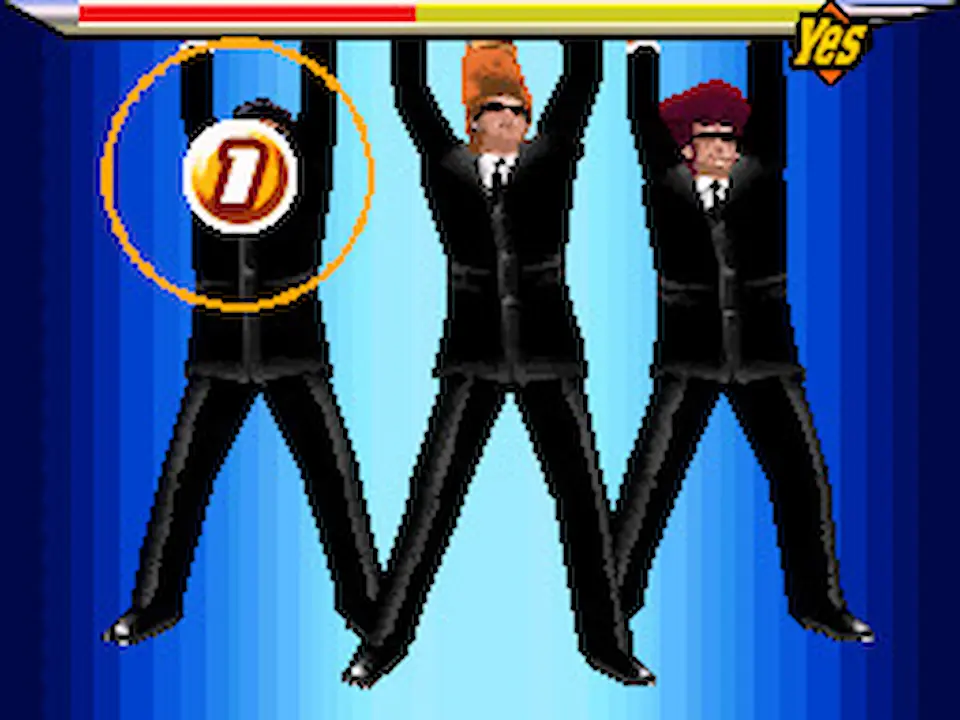
The agents bust a move as the first tap hits, kicking off the rhythm sequence in style.
I started on Cruisin’ difficulty, easily clearing the first few songs. However, when I reached tracks like September, Canned Heat, Let’s Dance, and the final song, the difficulty spiked significantly. After struggling through these tracks, I dropped down to Breezin’ to continue, only to find myself still facing tough challenges as the game neared its conclusion. Even on the easier setting, the final songs pushed my reflexes, requiring multiple attempts to pass, especially due to songs burying multiple taps under each other. This difficulty curve kept the game engaging, as each success felt earned, but the need to retry certain stages added both frustration and satisfaction, making the game’s progression feel rewarding.
To reward player mastery, the game includes a ranking system that scores performances with letter grades, from D to the coveted S rank. Clearing stages and hitting specific score thresholds unlocks bonus songs and extra content, encouraging replayability. Players can also save replays of their performances, a welcome feature that lets them revisit or share their best runs.
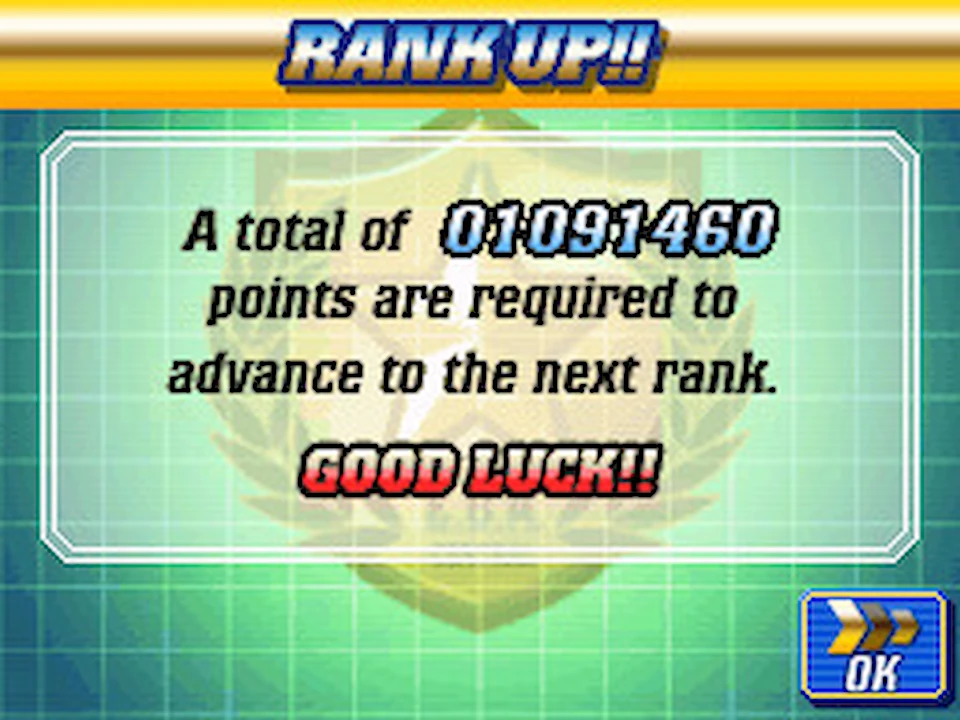
The Rank Up screen sets the next high-score target—because saving the world needs style and stats.
As the stages progress, the game ramps up in complexity, requiring sharper timing and quicker reactions. Unlike rhythm games that rely on physical peripherals or flashy dance mechanics, Elite Beat Agents thrives on its precision-focused, touchscreen-driven gameplay. Combined with its quirky storytelling and escalating difficulty, it delivers a rhythm experience that’s equally rewarding and addictively challenging.
Art & Audio
Elite Beat Agents boasts a diverse and memorable tracklist that spans multiple genres and eras. From pop-rock anthems to timeless classics, the song selection keeps every stage fresh and engaging:
- Madonna – Material Girl
- Sum 41 – Makes No Difference
- Earth, Wind & Fire – September
- Queen – I Was Born to Love You
- David Bowie – Let’s Dance
- Avril Lavigne – Sk8er Boi
- Chicago – You’re the Inspiration
While all the tracks are covers, the vocals and instrumentation are impressively close to the originals, far exceeding the “as made famous by” quality of earlier Guitar Hero covers.
The music isn’t just there for rhythm gameplay—it’s deeply tied to the game’s storytelling. Each song corresponds to its own quirky narrative, brought to life through vibrant, cartoon-style storyboards. These sequences unfold in a comic book panel layout, with exaggerated expressions and dynamic scenes that match the energy of the music. The art style is colorful, charming, and perfectly suited to the game’s over-the-top tone, making each mission feel like a self-contained, musical episode.
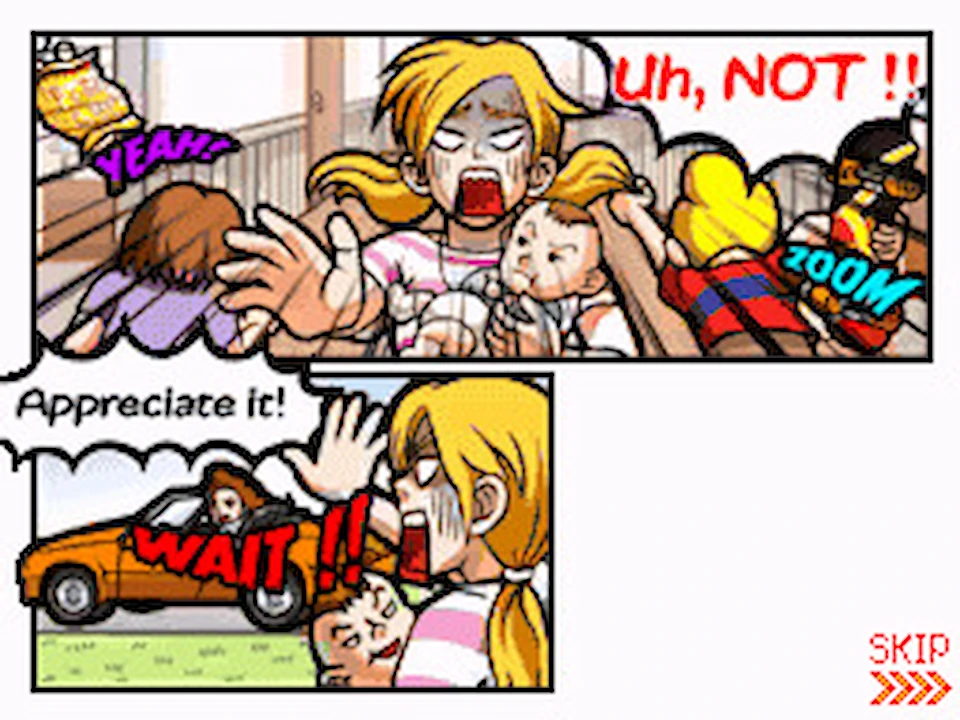
A dramatic storyboard moment unfolds as a man leaves a heartbroken woman behind, setting the emotional stage for the next rhythm challenge.
This seamless blend of music and visuals creates a unique experience where every song feels like a journey. Whether you’re helping characters overcome personal challenges or achieve their dreams, the combination of lively artwork and a varied tracklist amplifies the emotional impact of each stage.
Unique Features and Mechanics
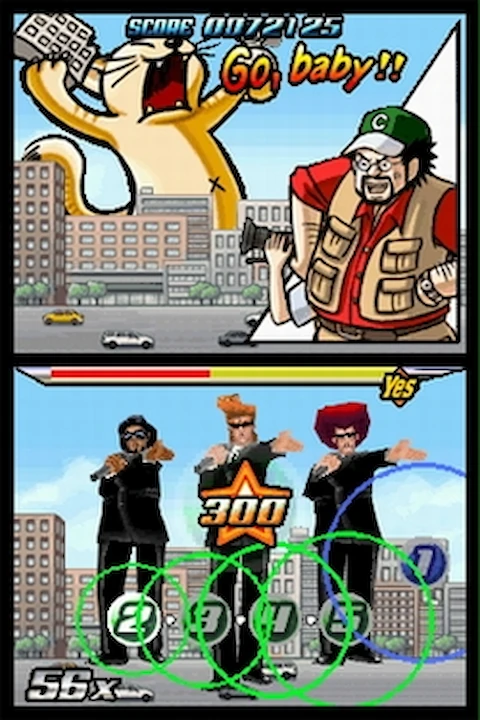
As a giant feline wreaks cinematic havoc, the agents break it down to save the day—on and off set.
Image Credit: HonestGamers
- Story-Driven Gameplay: Unlike most rhythm games, where the focus is solely on the music, Elite Beat Agents integrates its songs into quirky, self-contained stories. These narratives are visually represented in comic book-style panels that evolve based on your performance, creating an emotional connection between the gameplay and its outcomes.
- Touchscreen Mechanics with a Twist: While the use of a touchscreen for gameplay is similar to Osu!, Elite Beat Agents distinguishes itself with its mix of tap, slide, and spin mechanics, offering a more dynamic and physical interaction compared to traditional rhythm games that rely on buttons or peripherals.
- Visual Feedback in Storyboards: Success or failure in gameplay directly impacts the comic-style visuals, with scenes changing based on how well you perform. This interactive storytelling element adds a layer of immersion rarely seen in rhythm games.
- Humorous and Heartfelt Tone: The game leans into humor and exaggerated scenarios, like helping a dog reunite with its owner or assisting a weatherwoman in stopping a storm. This blend of comedy and sentimentality makes it a uniquely charming experience.
- Rewarding Replayability: While many rhythm games focus purely on skill mastery, Elite Beat Agents incentivizes replaying with unlockable songs tied to higher difficulties and performance thresholds.
Verdict
Elite Beat Agents is an interesting and noteworthy title in the DS’s library, a rhythm game that impresses with its unique touchscreen-based gameplay and quirky storytelling. While the difficulty curve starts off approachable, it quickly escalates, particularly in the later tracks. The challenge of passing songs like September and Let’s Dance—even on the Breezin’ difficulty—provides a satisfying test of precision, requiring multiple attempts and a keen sense of rhythm. This ramp-up in difficulty, especially as the game nears its final stages, is both rewarding and, at times, frustrating, but ultimately makes each success feel earned.
The game’s clever use of its touch controls, paired with catchy tracks and a memorable cast of characters, makes it a standout in the rhythm genre. Though some may find the difficulty spikes too abrupt, others will appreciate the challenge, with replayability encouraged by the ranking system and unlocked bonus content. Elite Beat Agents doesn’t just stand out for its mechanics; it’s a rhythm game that delivers a deeply engaging experience, blending precision with fun, and ensuring every song feels both rewarding and challenging.
TLDR
Elite Beat Agents (Nintendo 3DS)
8
Good
Summary: Elite Beat Agents offers a unique and engaging rhythm experience with its intuitive touchscreen mechanics and memorable soundtrack. The game’s quirky characters and storyboards keep things fun, while the precise gameplay demands sharp timing and focus.
However, the difficulty curve can be steep, even on the easiest setting, and the challenge may not be for everyone. Despite these challenges, the game’s replayability, catchy music, and entertaining visuals make it an iconic entry in the DS’s rhythm game library.
References
- Wishroom. (2006, October 30). Elite Beat Agents Commercial. YouTube.
- Nutt, C. (2007, September 14). Feeling The Elite Beat: Keiichi Yano On Crossing Over. https://www.gamedeveloper.com/business/feeling-the-elite-beat-keiichi-yano-on-crossing-over


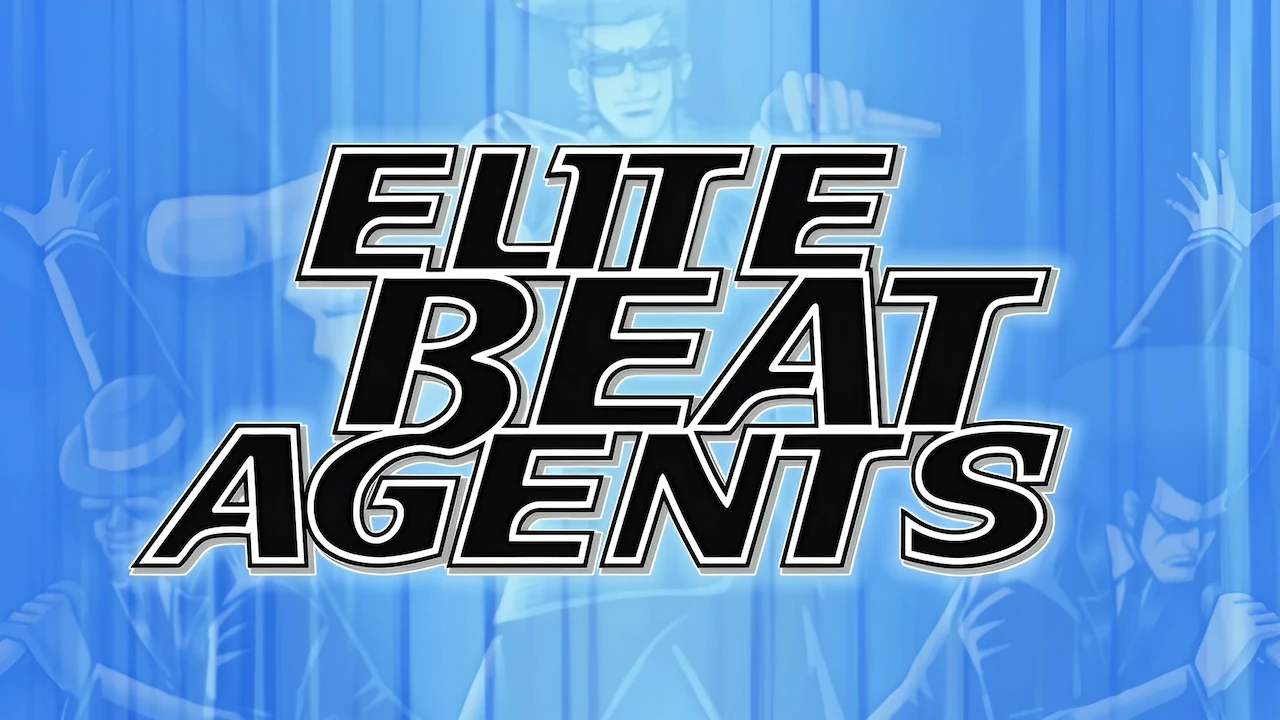
Leave a Reply